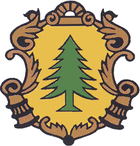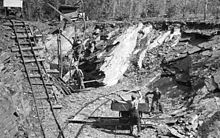Lehesten (Thuringian Forest)
| coat of arms | Germany map | |
|---|---|---|

|
Coordinates: 50 ° 28 ' N , 11 ° 27' E |
|
| Basic data | ||
| State : | Thuringia | |
| County : | Saalfeld-Rudolstadt | |
| Management Community : | Slate mountains | |
| Height : | 640 m above sea level NHN | |
| Area : | 35.94 km 2 | |
| Residents: | 1672 (Dec. 31, 2019) | |
| Population density : | 47 inhabitants per km 2 | |
| Postal code : | 07349 | |
| Primaries : | 036653, 036652 (burner green) | |
| License plate : | SLF, RU | |
| Community key : | 16 0 73 046 | |
| City structure: | 3 districts | |
City administration address : |
Obere Marktstrasse 1 07349 Lehesten |
|
| Website : | ||
| Mayor : | René Bredow (Citizens' Initiative Lehesten eV) | |
| Location of the city of Lehesten in the Saalfeld-Rudolstadt district | ||
Lehesten is a mountain and slate town in the Saalfeld-Rudolstadt district in Thuringia . The city belongs to the administrative community Schiefergebirge , which has its administrative seat in the municipality of Probstzella .
geography
Lehesten is located in the south-eastern part of the Thuringian Forest , the Thuringian Slate Mountains, directly on the Rennsteig .
Neighboring communities
Lehesten borders on Ludwigsstadt in the west, Teuschnitz , Reichenbach and Tschirn in the south, Wurzbach in the east and Probstzella in the north .
City structure
The districts of Brennersgrün , Röttersdorf and Schmiedebach with the settlement of Bärenstein belong to the city .
history
The "Kantors Island" is a medieval castle one kilometer north of Lehesten, just before the junction to Schmiedebach. A small ring wall has been preserved at the upper exit of the Wiesental. The moat around this area has been preserved and the wall can still be seen. It was probably a mansion. Lehesten was first mentioned in a document in 1071. In the Middle Ages the village belonged to the Saalfeld monastery . From the middle of the 17th century, the place developed into a town due to its location on the road from Kronach to Pößneck . From 1651 a council consisting of a mayor and three assessors is documented.
In 1911, the German technical school for the roofing trade was founded in Lehesten im Friedrichsbruch.
In the “Fröhlichen Tal” near today's Schmiedebach district, engines for the V2 rocket were built and tested by up to 1,227 prisoners of war during World War II . When forced laborers died or fell ill due to the inhuman living conditions, the occupancy was replenished by new arrivals from the Buchenwald concentration camp or from main camps . In addition to the 603 known fatalities, there were at least a thousand other prisoners who had been deported to the Bergen-Belsen and Dora-Mittelbau concentration camps. Numerous other prisoners died on the evacuation marches in April 1945. A memorial stone that was first erected has been a reminder of the tragedy since 1956 and a memorial since 1979, which has been gradually rebuilt since 1989.
The name was changed on May 1, 1992, when the town of Lehesten / Thür. Renamed forest Lehesten.
On January 22, 1994, the community of Brennersgrün was incorporated. On April 6, 1994, the communities Schmiedebach and Röttersdorf followed.
politics
City council
The council of the city of Lehesten consists of twelve municipal councils. The local elections on May 26, 2019 led to the following result:
| Party / list | Seats | Share of votes |
| Close to the citizen (BN) | 5 | 46.0% |
| Citizens' Initiative Lehesten (BI) | 4th | 30.1% |
| Alternative for Germany (AfD) | 1 | 11.5% |
| Social Democratic Party of Germany (SPD) | 1 | 6.5% |
| Free voters | 1 | 5.9% |
mayor
The honorary mayor René Bredow was elected on January 31, 2016.
coat of arms
Blazon : "A stylized, rooted fir tree in gold."
Culture and sights
Museums
- Technical monument historical slate mining / Lehesten slate park
- Laura Concentration Camp Memorial (Merry Valley)
Natural monuments
About four kilometers south of Lehesten is the Wetzstein , the second highest mountain in the Franconian Forest . The Altvaterturm was built a little below the summit in the years 2000-2004 . One of the old slate pits about a kilometer south of Lehesten in the Staatsbruch nature reserve has overflowed with water and creates a bathing area with clear and refreshing water in midsummer, which is warmed by the slate. However, due to the alum content , the water should not be drunk.
Buildings
- In the anteroom of the church there is the largest slate ever carved in one piece (308 × 253 cm).
- In Schieferpark is Europe's only preserved Pferdegöpel
Economy and Infrastructure
Mining and commerce
The economic basis of the city was the slate mining , documented from the end of the 15th century . There were two large slate quarries, the rulership breach belonging to the duchy and the Oertelsbruch, named after its owner. The ducal slate quarries were taken over by the Free State of Saxony-Meiningen at the end of 1918 , until they finally passed into the possession of the State of Thuringia in 1920. The extraction was stopped in 1999. The Lehesten opencast mines are considered to be the most extensive on the European mainland and are accessible as a technical monument for historical slate mining .
In the early years of the division of Germany , there was the special feature that in the slate quarries of the Lehestener Revier up to around 300 workers from neighboring towns in Upper Franconia were employed, most of whom were paid in D-Marks . For a while there was a special bus service for rush- hour traffic via a nearby border crossing near the Ziegelhütte property . After the further tightening of the border regime on the inner-German border in connection with the construction of the Berlin Wall , the 72 employees who remained at the time were offered continued employment on the condition that they would move to the GDR with their families . This offer was not accepted by anyone, so that the employment relationship ended in mid-September 1961.
In the wake of slate extraction, a major roofing trade with the oldest master roofing school in Germany was established in Lehesten. Up until the construction of the railway line to Lehesten, numerous haulage companies were also based in the city, whose predominant transport goods were also slate (slate transport regulations from 1698).
traffic
Lehesten is on the Thuringian-Franconian Slate Road .
On December 1, 1885, the 7.6 km long Ludwigsstadt – Lehesten railway was opened by the Royal Bavarian State Railways . Since after the end of the Second World War the route crossed the inner-German border between the American and Soviet occupation zones , passenger traffic was no longer taken up. From 1947 to 1951, however, there was still freight transport for slate removal until the route through the GDR was finally closed on July 11, 1951.
Personalities
- Oskar Bulle (1857–1917), writer and lexicographer
literature
- Hans Patze , Peter Aufgebauer (Ed.): Handbook of the historical sites of Germany . Volume 9: Thuringia (= Kröner's pocket edition . Volume 313). 2nd, improved and supplemented edition. Kröner, Stuttgart 1989, ISBN 3-520-31302-2 .
- Henry Hatt: Ignored Hitler's Secret Objects. Traces of art robbery in mines. A book about the processing of the events in Thuringia's slate mines during the Second World War. Hattenhauer, Ludwigsstadt 1995, ISBN 3-930988-00-3 (Lehesten was also known in connection with the alleged hiding place of the Amber Room).
Web links
- City website
- Chronicle from 900 to 1921
- Copy of the book "Lehesten in the Past" by Medical Councilor Dr. Peetz
Individual evidence
- ^ Population of the municipalities from the Thuringian State Office for Statistics ( help on this ).
- ↑ Michael Köhler : Thuringian castles and fortified prehistoric and early historical living spaces. Jenzig-Verlag Köhler, Jena 2001, ISBN 3-910141-43-9 , p. 181.
- ^ Off to the exhibition Das Dach in Lehesten . In: Thüringerwaldverein (Ed.): Thuringian monthly sheets . tape 44 . Eisenach 1936, p. 97 .
- ↑ Thuringian Association of the Persecuted of the Nazi Regime - Association of Antifascists and Study Group of German Resistance 1933–1945 (Ed.): Local history guide to sites of resistance and persecution 1933–1945. Volume 8: Thuringia. VAS - Verlag für Akademische Schriften, Frankfurt am Main 2003, ISBN 3-88864-343-0 , p. 235 f.
- ↑ City council election 2019 in Thuringia - final result city of Lehesten
- ^ Peter E. Fässler: Westarbeiter in der DDR (1949–1961) . In: Institute for contemporary history (ed.): Quarterly books for contemporary history . 49th year, no. 4 , 2001, p. 613–642 ( Online [PDF; 1.3 MB ; accessed on January 13, 2017]).
- ↑ Hole in the Iron Curtain. In: www.ludwigsstadt.de. April 27, 2011, accessed January 13, 2017 .
- ↑ Steffi Mehlhorn, Joachim Dresdner: Rennsteig for Cars - Out and about on the Thuringian-Franconian Slate Road. In: Deutschlandfunk. June 29, 2008, accessed January 13, 2017 .







